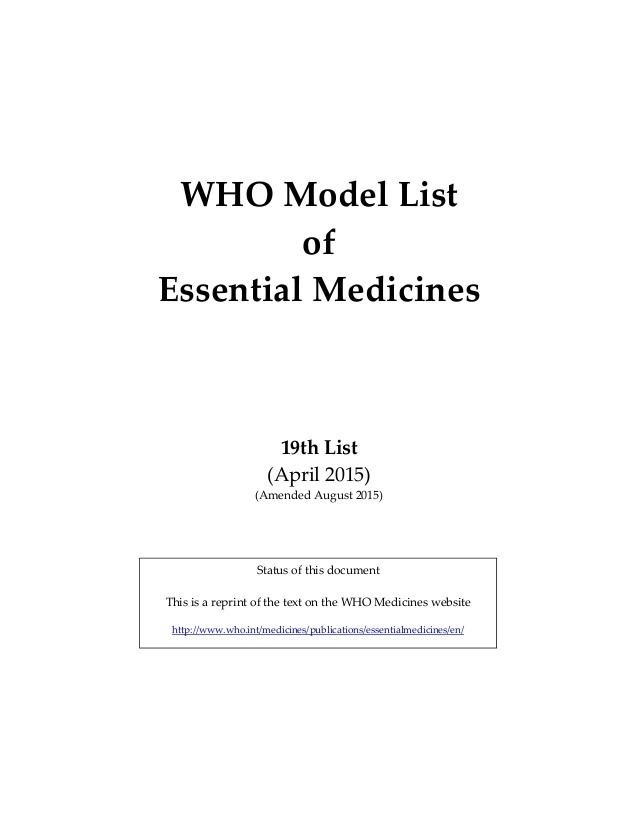 | ||
The WHO Model List of Essential Medicines (EML), proposed by the World Health Organization (WHO), contains the most effective and safe medicines needed to meet the most important needs in a health system. The list is frequently used by countries to help develop their own local lists of essential medicine. As of 2016, more than 155 countries have created national lists of essential medicines based on the World Health Organizations model list. This includes countries in both the developed and developing world.
Contents
- Inhalational medicines
- Injectable medicines
- Local anaesthetics
- Preoperative medication and sedation for short term procedures
- Nonopioids and nonsteroidal anti inflammatory drugs NSAIDs
- Opioid analgesics
- Medicines for other common symptoms in palliative care
- Antiallergics and medicines used in anaphylaxis
- Nonspecific
- Specific
- Anticonvulsive medication
- Intestinal antihelminthics
- Antifilarials
- Antischistosomals and other antinematode medicines
- Beta Lactam medicines
- Other antibacterials
- Antileprosy medicines
- Antituberculosis medicines
- Antifungal medicines
- Antiherpes medicines
- Antiretrovirals
- Antihepatitis medicines
- Antiamoebic and antigiardiasis medicines
- Antileishmaniasis medicines
- Antimalarial medicines
- Antipneumocystosis and antitoxoplasmosis medicines
- Antitrypanosomal medicines
- Acute attack
- Prevention
- Immunosuppressive medicines
- Cytotoxic and adjuvant medicines
- Hormones and antihormones
- Antiparkinsonism medicines
- Antianaemia medicines
- Medicines affecting coagulation
- Other medicines for haemoglobinopathies
- Blood and blood components
- Human immunoglobulins
- Blood coagulation factors
- Plasma substitutes
- Antianginal medicines
- Antiarrhythmic medicines
- Antihypertensive medicines
- Medicines used in heart failure
- Anti platelet medicines
- Thrombolytic medicines
- Lipid lowering agents
- Anti infective medicines
- Anti inflammatory and antipruritic medicines
- Medicines affecting skin differentiation and proliferation
- Scabicides and pediculicides
- Ophthalmic medicines
- Radiocontrast media
- Antiseptics
- Disinfectants
- Diuretics
- Gastrointestinal medicines
- Antiulcer medicines
- Antiemetic medicines
- Anti inflammatory medicines
- Laxatives
- Oral rehydration
- Medicines for diarrhea in children
- Adrenal hormones and synthetic substitutes
- Androgens
- Oral hormonal contraceptives
- Injectable hormonal contraceptives
- Intrauterine devices
- Barrier methods
- Implantable contraceptives
- Intravaginal contraceptives
- Insulins and other medicines used for diabetes
- Ovulation inducers
- Progestogens
- Thyroid hormones and antithyroid medicines
- Diagnostic agents
- Sera and immunoglobulins
- Vaccines
- Muscle relaxants peripherally acting and cholinesterase inhibitors
- Anti infective agents
- Anti inflammatory agents
- Local anesthetics
- Miotics and antiglaucoma medicines
- Mydriatics
- Anti vascular endothelial growth factor VEGF
- Oxytocics and abortifacients
- Antioxytocics tocolytics
- Peritoneal dialysis solution
- Medicines used in psychotic disorders
- Medicines used in depressive disorders
- Medicines used in bipolar disorders
- Medicines for anxiety disorders
- Medicines used for obsessive compulsive disorders
- Medicines for disorders due to psychoactive substance use
- Antiasthmatic and medicines for chronic obstructive pulmonary disease
- Oral
- Parenteral
- Miscellaneous
- Vitamins and minerals
- Ear nose and throat medicines in children
- Medicines administered to the neonate
- Medicines administered to the mother
- Medicines used to treat gout
- Disease modifying agents used in rheumatoid disorders
- Juvenile joint diseases
- References
The list is divided into core items and complementary items. The core items are deemed to be the most cost effective options for key health problems and are usable with little additional health care resources. The complementary items frequently require additional infrastructure such as specially trained health care providers or diagnostic equipment. About 25% of items are in the complementary list. Some medications are listed as both core and complementary.
The first list was published in 1977 and included 212 medications. The WHO updates the list every two years. The 14th list was published in 2005 and contained 306 medications. In 2015 the 19th edition of the list was published and contains around 410 medications. The 20th edition is expected to be published in 2017. The national lists contain between 334 and 580 medications.
A separate list for children up to 12 years of age, known as the WHO Model List of Essential Medicines for Children (EMLc), was created in 2007 and is in its 5th edition. It was created to make sure that the needs of children were systematically considered such as availability of proper formulations. Everything in the children's list is also included in the main list. The following list is based on the 19th edition of the adult list.
Inhalational medicines
Injectable medicines
Local anaesthetics
Preoperative medication and sedation for short-term procedures
Nonopioids and nonsteroidal anti-inflammatory drugs (NSAIDs)
Opioid analgesics
Medicines for other common symptoms in palliative care
Antiallergics and medicines used in anaphylaxis
Nonspecific
Specific
Anticonvulsive medication
Intestinal antihelminthics
Antifilarials
Antischistosomals and other antinematode medicines
Beta Lactam medicines
Other antibacterials
Antileprosy medicines
Antituberculosis medicines
Antifungal medicines
Antiherpes medicines
Antiretrovirals
Nucleoside/nucleotide reverse transcriptase inhibitors
Non-nucleoside reverse transcriptase inhibitors
Protease inhibitors
Fixed-dose combinations
Antihepatitis medicines
Medicines for hepatitis B
Nucleoside/Nucleotide reverse transcriptase inhibitors
Medicines for hepatitis C
Nucleotide polymerase inhibitors
Protease inhibitors
NS5A inhibitors
Non-nucleoside polymerase inhibitors
Other antivirals
Fixed-dose combinations
